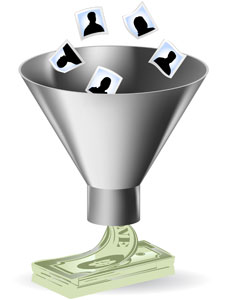Sales tactics part 2: Customer engagement


In April the Adagio Retail Management team set out to adjust the Customer Engagement Process to increase the Average Sale while improving customer satisfaction. We achieved a 25% increase in average ticket (during a season when the average tickets usually drop), and here's how we did it. (Click here for Part 1 of this Sales Tactics series)
The first challenge is to identify and correct any misconceptions about the salesperson/customer relationship among the employees. Success required that the team not only understand and be able to replicate the desired approach, but also that they believe that the right customer engagement strategy would have the dual effect of increasing sales AND customer satisfaction and loyalty.
The core perspective that we must bring to the Customer Engagement is that the salesperson and customer are NOT adversaries. The casual consumer out shopping retail stores is not the victim but the hunter. They are in search of something to buy. They WANT to find an service, product or experience that is worth more to them than their hard earned cash. The role of the salesperson is to help guide the customer to a decision that will make them happy, and away from purchases that will fall short of expectations for whatever reason. The salesperson is the defender of the brand, and our best hope for ensuring consistently delighted customers. The best path to success is not tricking the customer into one large purchase, but introducing them to the product, knowledge or experience that will keep them coming back time and time again. Failing to provide a customer with the information or guidance needed to maximize their experience is just as bad as pushing them into a product they don't really want or need.
Armed with the proper perspective, we moved into training on the Six Keys to Successful Customer Engagement:
1. Warmth
You are an actor, and the sales floor is your stage. Play the "ideal you". ACT if you must. Be casual, friendly and welcoming. You aren't imposing or intruding... they came into YOUR store. Most customer interactions are only awkward if you are awkward. A comfortable, confident person puts everyone else around them at ease. Earn every sale by making every customer feel as though they are the center of your universe.
2. Passion
Passion is contagious. Happiness, fun, and warmth are contagious, and are the opposite of awkward and shy. Remember what you are selling! Tea is beautiful, rare and precious. It is a hand-made work of art! Be PROUD! The opportunity in your store is unparalleled! The aromas, flavors, nuances and opportunity to experience the leaf CANNOT be found anywhere else. Remember, we're not selling tea, we're selling happiness:
- The dopamine rush of discovery
- The dopamine rush of making a purchase
- The satisfaction and sensory fulfillment of unpacking and enjoying the purchase at home
- The pride and personal fulfillment of having a rare piece of knowledge
- The sense of belonging to an exclusive group of "enlightened" tea connoisseurs
Remember that the customer is LOOKING for something that they want more than their money. Your job is to show them how great your product is. Their perception of the value of your product is based on YOU and your passion.
3. Observation
Not every customer is looking for the same thing:
- Tea connoisseur vs. casual drinker vs. new to tea
- Sensory experience vs. intellectual discovery
- Tastes good vs. good for me
- Experience (calming) vs. functional (caffeine free)
- Fruity flavors vs. socially/environmentally conscious
- Value vs. luxury
- Personal vs. gift
Seek first to understand, and then to be understood. You will only get ONE shot at converting each person that walks through the door. Choose your approach carefully.
4. Knowledge
Each employee should be able to identify the features, benefits and price of every product in the store. The customer usually doesn't want a lot of information, so depth is less important than context. We MUST be able to put each product in context and provide a comparative analysis (Which should I choose? Why is it more expensive? Which one is less astringent?). The ultimate goal is to be able to answer every question with a specific product recommendation, and to know the collection well enough to be concise!
5. Communication
Sales people should be warm, passionate, targeted and BRIEF! This requires focus and practice. Each employee will end up going through the process a little differently and adjusting the approach to make use of their own personal strengths (humor, knowledge, personality, personal story, etc.). Every employee must master the process and then make it their own:
- Greet
- Engage
- Recommend
- Demonstrate
- Consult
- Ask for the sale
- Assume the add-on
- Educate (How to brew or how it works)
- Inform (loyalty program, upcoming events, etc.)
6. Tactics
Tactics in retail sales are usually an attempt to make up for cold, shy, bored, lazy, uninformed sales people (think scripts that ignore the customer and circumstances). Real sales tactics are simply applied understanding of human behavior. Employees should practice and master the art of:
- Personal connection
- Recognizing repeat customers
- Humor
- Personal recommendations
- Participating in the experience
- Asking for the sale
- Extending the sale
- Assuming the add-on
- Educating without overwhelming
- Serving instead of selling
At the end of the day, it comes down to great people and great execution. People buy from people; are served by people; build relationship with people. The best brand and best marketing story will appear nothing more than slick and shallow marketing if the people behind it are not authentic. The most perfectly designed and merchandised store will fail to resonate with the customer if the eyes of the person behind the counter are dead and uninterested. The greatest works of screen, stage or orchestra fall flat unless they are performed with passion.
--------------------------------------------
This article is a continuation of the Profitability Strategies Series:
1. Package size
2. Pricing
3. Sales Strategies Part 1 and Part 2
4. Merchandising display strategies
5. In-store marketing and signage
Adagio Teas
Twitter: @AdagioRetail
